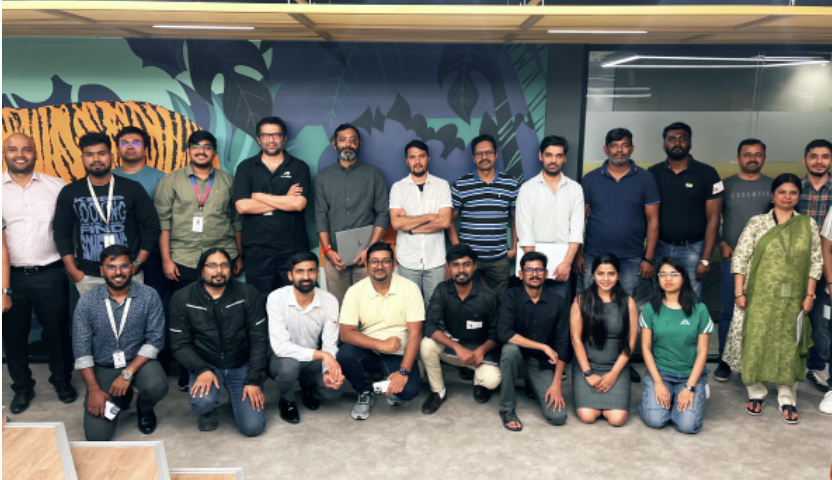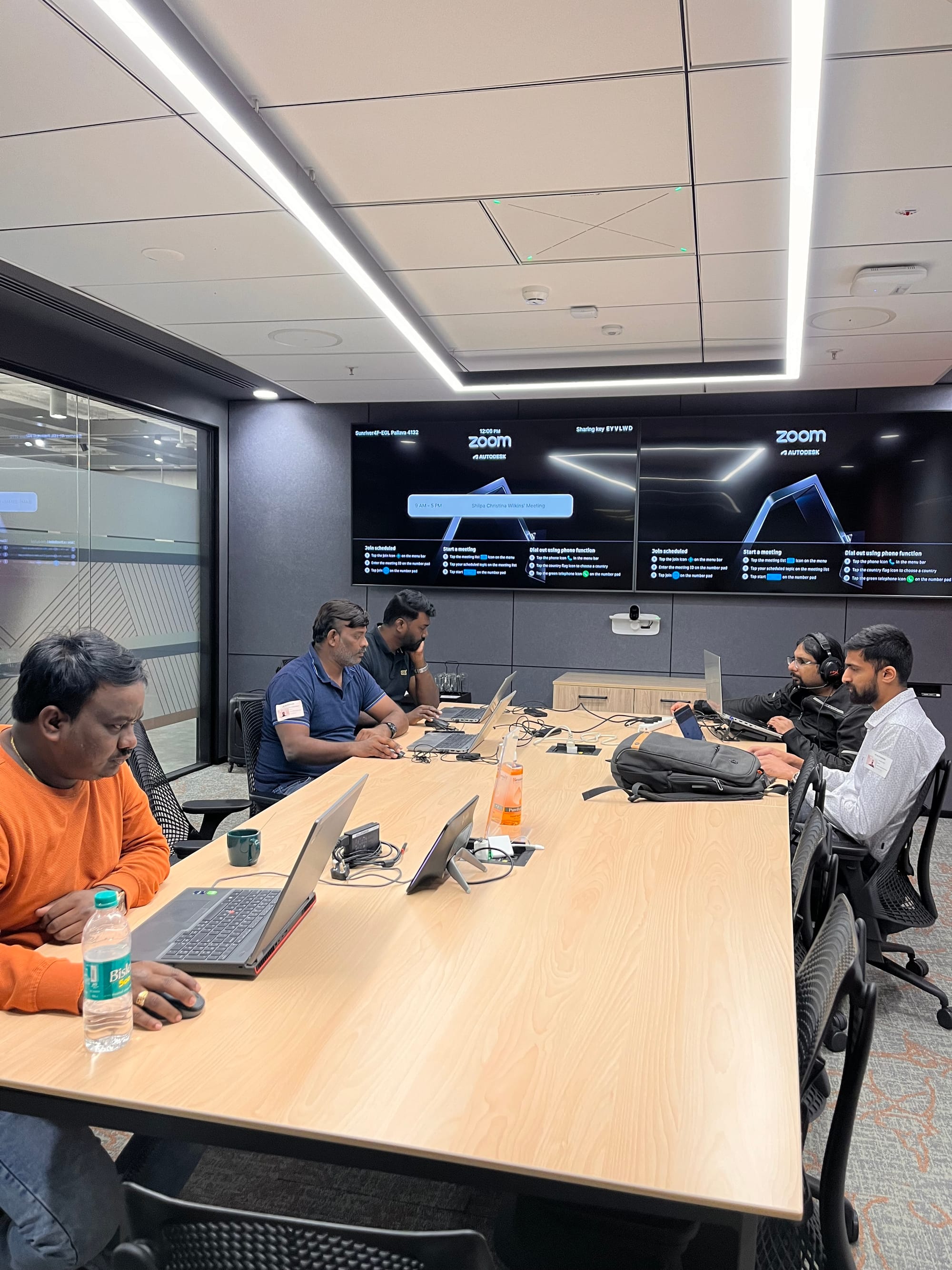My Week at the Autodesk Accelerator
A dev's inside look at the intense, collaborative Autodesk APS Accelerator.

I’m a developer at 1985, and I think I have been here since..as long as I could remember (and I totally love it here). So recently, my team decided I needed a serious dose of now, so they shipped me off to the Autodesk Platform Services (APS) Accelerator. One week, neck-deep in cloud APIs, generative AI buzz, and agile sprints, trying to build something cool that connects with the tools real projects use every day, like Autodesk Construction Cloud (ACC).
Honestly? I was skeptical. "Accelerator" sounds like corporate jargon for "let's talk about synergy while drinking stale coffee." But what actually went down over those five days genuinely blew my mind and changed how I think about building stuff fast, especially when integrating with complex platforms like ACC.
Here’s the lowdown.

Monday: Diving Straight In
Things kicked off Monday morning, and forget gentle intros. The Autodesk folks basically said, "Alright, here's the plan, you've got a project, let's get building." Everyone showed up with a real-world problem they wanted to solve or prototype using Autodesk's tech.
My mission, should I choose to accept it, was a concept from 1985: integrating BIM data from Autodesk Construction Cloud (ACC) seamlessly with real-time analytics. The goal was to pull project data directly from ACC using APS, process it, and visualize insights without manual exports. Sounds fancy, right? Maybe a bit too ambitious for a week, given the complexities of ACC data structures? That was the big question.
The vibe wasn't "listen to us lecture," it was "let's build this together." By mid-morning, we were already in our own corners, firing up IDEs. My afternoon was a blur of setting up dev environments, digging through Autodesk API docs (specifically the ones for accessing ACC data via APS), sketching out architectures, and pinging Autodesk engineers on Slack. They were right there, answering questions about ACC data models, authentication flows, and APS endpoints.
By the end of day one, my skepticism was fading. We weren't just talking; we were coding. Something tangible that actually talked to ACC was starting to take shape.

Tuesday to Thursday: Coding and Collaboration at Warp Speed
Tuesday hit like a git push --force. I jumped straight back into the code, riding the momentum from Monday. The APS Accelerator isn't a class; it's a hands-on workshop cranked up to eleven. Think of it like the most intense, focused agile sprint you've ever been on, but with experts on tap who know the ins and outs of ACC and APS.
My days fell into a familiar rhythm for any dev: code, test, debug, figure out why the ACC API call failed, find the right scope, fix, test again, repeat. The huge difference? I wasn't stuck deciphering API docs alone. The Autodesk engineers were right there. Got a weird response querying ACC issues? Stuck on getting the right version of a model from ACC Docs? Performance tanking when pulling large datasets? You could grab someone, share your screen, and work through it.
For example, my first crack at streaming BIM data from ACC through APS was functional but slow. An Autodesk engineer took a look, pointed out a more efficient way to query the ACC data using specific APS endpoints and filters, and we basically pair-programmed a refactor right then and there. An hour later, the data was flowing smoothly from ACC to my application. That kind of instant, expert help specifically tailored to working with ACC via APS is gold.
It wasn't just me, either. You could hear similar conversations happening all around. Devs from different companies, working on everything from automating RFI workflows in ACC to visualizing safety data pulled from ACC projects, all hitting walls and then breaking through them with a little help.
We had quick sync-ups each evening to share wins, blockers (often related to specific ACC API nuances), and plan adjustments. It kept things moving and built a real sense of camaraderie – like we were all navigating the complexities of cloud integrations together.
Wednesday night, Autodesk threw a dinner. Usually, "networking event" makes me want to hide, but this was actually chill. Just devs talking shop, comparing notes on ACC integrations, debating the merits of different frameworks, and sharing war stories. It felt less like a corporate function and more like a meetup.

Friday: Demo Day – The Moment of Truth
Friday was the grand finale: Demo Day. Fifteen minutes each to show what we'd built. The energy was a mix of excitement and pure, unadulterated "please let the ACC API respond quickly" terror. This wasn't about slide decks; it was about showing running code interacting with real platforms.
When my turn came, I fired up the app. It connected to an ACC project, pulled BIM data streams and issue information via APS, crunched numbers in real-time, and lit up some dashboards. Was it perfect? Heck no, live demos never are. But it worked. It showed that the core idea – integrating live ACC data with external analytics – was totally doable, and we'd hacked together a solid proof-of-concept in just five days. That felt pretty awesome.
The feedback from the Autodesk team was specific, helpful, and genuinely encouraging. They pointed out areas to improve, suggested more advanced APS endpoints for richer ACC data access, and discussed potential scaling strategies. Seeing what everyone else built was also super inspiring – AI analyzing construction site photos stored in ACC, automated workflows triggering actions within ACC projects... crazy cool stuff built incredibly fast.
Technologies That Defined the Week
Throughout the accelerator, three core technology areas stood out:

APS was the essential gateway. It's the flexible set of APIs that let us programmatically interact with data and services within platforms like Autodesk Construction Cloud. We also had a session on Generative AI (with AWS folks joining), which sparked ideas about how AI could leverage the rich data stored in ACC. And the whole week ran on agile principles – build small, test often, talk constantly. It was intense, but incredibly productive.
Reflections from a Developer
Honestly, this accelerator week really shifted my perspective. You always hear about rapid prototyping and intense collaboration, but living it for a week showed me what's possible when you have the right tools (like APS) to connect to the right platforms (like ACC) and, crucially, the right people helping you.
The biggest takeaway wasn't just the tech; it was the access to the Autodesk engineers who deeply understand both APS and the intricacies of ACC. Having that direct line for help, feedback, and brainstorming turned it from a standard workshop into a supercharged dev sprint focused on real-world construction tech problems. Their commitment to helping us actually build something that integrated with ACC was clear.
I'm definitely bringing back some of this energy (and a few specific API tricks for ACC) to 1985. We're already thinking differently about how we tackle complex integrations and prototypes involving ACC.
So, Should You Go?
Look, the APS Accelerator isn't a vacation. It's a full-on, high-intensity dive into building stuff with Autodesk's cloud platform, often targeting integrations with ACC. But if you've got a challenging project involving ACC data, an ambitious idea for automating construction workflows, or just want to see how much you can really get done in a week with expert support, it's an amazing experience. It's like a boot camp for construction tech innovation.
For us at 1985, it was exactly the kickstart we needed. It yanked me out of my comfortable coding cave and showed me what's possible when connecting the modern web with platforms like ACC. And yeah, I’d totally do it again. Sometimes, a jump from 1985 straight into the future of connected construction is the best way to accelerate.


